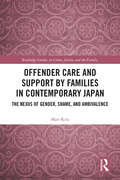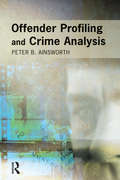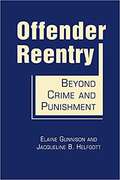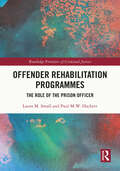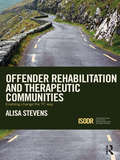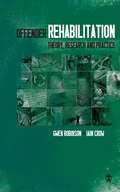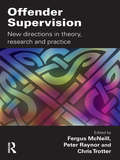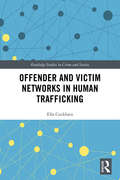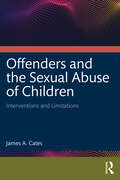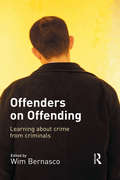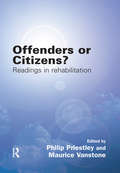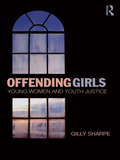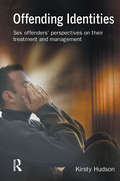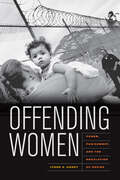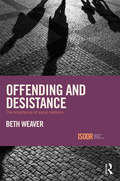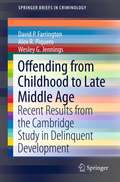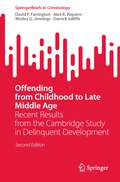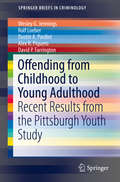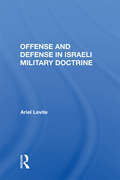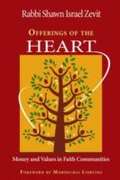- Table View
- List View
Off-White: The Truth About Antisemitism
by Rachel ShabiWhy can't we talk about antisemitism? 'I am so grateful to Rachel Shabi for this supple, generous and original investigation into the uses and abuses of antisemitism... I cannot wait for Off-White to be read, debated and put into practice.' Naomi Klein, author of Doppelganger As claims of antisemitism continue to distort our politics at home and abroad, it has become almost impossible to talk about constructively, even in private. Instead, we find ourselves in a storm of misinformation, political mudslinging and bad-faith accusations. There is, however, a way to deliberate more honestly. Looking beyond our polarising headlines and interrogating the reasons racism takes hold, Off-White offers urgent analysis of one of the most divisive issues of our time. Taking in the contingency of whiteness, Judeo-Christian mythmaking, pro-Israel antisemitism, and the Palestinian struggle against colonialism, Rachel Shabi lights a hopeful way forward. *** 'Timely and valuable... [Shabi's] key message is a vital one – that the fight against antisemitism is an essential part of the fight against all injustice and dehumanisation.' Observer, Book of the Week 'A masterpiece defined by moral clarity, humanity and insight.' Owen Jones 'An invaluable guide for anyone who seeks to understand issues over which we stumble far too often.' George Monbiot 'With a generous spirit and a humane compass, Rachel Shabi guides us through a minefield.' Gary Younge
Offender Care and Support by Families in Contemporary Japan: The Nexus of Gender, Shame, and Ambivalence (Routledge Studies in Crime, Justice and the Family)
by Mari KitaBecause people’s contact with the criminal justice system comes in different shapes and forms, scholars are now broadening their analytical scope and examining the overall repercussions of criminal justice contact on families of offenders. Compared to Western societies, Japan is known for its lower crime rates and more pronounced use of informal social control. Thus, it offers a useful research site for examining how families in a low-crime society experience criminal justice contact and how they function as an integral part of the nation’s crime control mechanism. This book considers the role of the family in the lives of offenders and the criminal justice system in Japan. Looking particularly at gender and patriarchal power relations, it reveals how cultural notions of femininity prompt the criminal justice system to rely on women as its proxy. This book explores how families of offenders often step in to fill the voids left by criminal justice institutions and social services to provide offenders with all-inclusive care. The burden of supervising and rehabilitating offenders on top of the expectation to atone for the crimes also renders families ambivalent and ashamed. Whereas the state and criminal justice authorities tend to see offenders’ families as a crucial resource for prisoner reentry, this book highlights the necessity for addressing families’ needs before automatically assuming their support. It also pushes the boundaries of feminist criminology by showing how women can be affected by male criminality and male-dominated criminal justice institutions, other than as victims and offenders. An accessible and compelling read, this book will appeal to students and scholars of criminology, sociology, gender studies, Japanese culture and all those interested in learning more about the criminal justice system in Japan.
Offender Profiling and Crime Analysis
by Peter AinsworthOffender Profiling and Crime Analysis provides a highly readable account of the subject, and a picture of profiling which by no means accords with popular views and representations of what is involved. The book provides an overview of profiling techniques, offering some fascinating insights into the various approaches to profiling, and schools of thought, which have emerged ? looking particularly at the work of the FBI, and of British and Dutch profilers.
Offender Reentry: Beyond Crime and Punishment
by Elaine Gunnison Jacqueline B. HelfgottIn this comprehensive exploration of the core issues surrounding offender reentry, Elaine Gunnison and Jacqueline Helfgott highlight the constant tension between policies meant to ensure smooth reintegration and the social forces―especially the stigma of a criminal record―that can prevent it from happening. <p><p> Gunnison and Helfgott focus on the factors that enhance reentry success as they address challenges related to race, class, and gender. Drawing on accounts from corrections professionals and former inmates to illustrate the real-life consequences of reentry policy, they shed light on one of the key criminal justice issues of our time.
Offender Rehabilitation Programmes: The Role of the Prison Officer (Routledge Frontiers of Criminal Justice)
by Laura M. Small Paul M.W. HackettThis book shows how prison officers may be able to significantly influence extra-programmatic conditions, to enhance rehabilitation outcomes and contribute to reducing reoffending. It does so through a detailed review of the literature relating to prison-based rehabilitation programmes, examining factors influencing their outcomes and the effects of the prison officer role. Firstly the book explores current understandings about the role of the prison and effective offender rehabilitation programmes. It then describes the processes of the integrative review of how prison officers can support rehabilitation programmes in prisons. Review findings suggest three main routes by which prison officers can contribute to enhancing rehabilitation outcomes: influencing prison social environments, enhancing prisoner treatment readiness and programme engagement and identifying and supporting prisoners’ wider needs. This book also explores avenues for further research in this area using a declarative sentence mapping approach. Bridging two previously distinct areas of research - prison officers and their role; and prison rehabilitation interventions – this book offers new understanding in the real-world context of prisons and their staff as to how we can enhance rehabilitation outcomes. It will be of great interest to academics in penology, forensic psychology, probation, and offender rehabilitation fields. The book is also valuable to postgraduate students and professionals working on prison policy.
Offender Rehabilitation and Therapeutic Communities: Enabling Change the TC way (International Series on Desistance and Rehabilitation)
by Alisa StevensOffender rehabilitation has become increasingly and almost exclusively associated with structured cognitive-behavioural programmes. For fifty years, however, a small number of English prisons have promoted an alternative method of rehabilitation: the democratic therapeutic community (TC). These prisons offer long-term prisoners convicted of serious offences the opportunity to undertake group psychotherapy within an overtly supportive and esteem-enhancing living environment. Drawing upon original research conducted with ‘residents’ (prisoners) and staff at three TC prisons, Offender Rehabilitation and Therapeutic Communities provides a uniquely evocative and engaging portrayal of the TC regime. Individual chapters focus on residents’ adaptation to ‘the TC way’ of rehabilitation and imprisonment; the development of caring relationships between community members; residents’ contributions towards the safe and efficient running of their community; and the greater assimilation of sexual offenders within TCs for men, made possible in part by a lessening in ‘hypermasculinity’. By analyzing residents’ own accounts of ‘desistance in process’ in the TC, this book argues that TCs help offenders to change by enabling positive developments to their personal identity and self-narratives: to the ways in which they see themselves and their life. The radically ‘different’ penal environment allows its residents to become someone ‘different’.
Offender Rehabilitation: Theory, Research and Practice
by Mr Iain Crow Gwen Robinson'Robinson and Crow have achieved the seemingly impossible: a book about rehabilitation that transcends the "medical model", that is original and contemporary yet grounded in a sophisticated history, and most of all that is fun to read. It will become a new classic text in a field that has been crying out for one' - Professor Shadd Maruna, Queen's University, Belfast 'In an age where there is much public and political confusion about many criminal justice matters, this book brings considerable clarity to the idea of rehabilitation, its theoretical and historical roots, and contemporary practical application. This is an accessible, lively, and critical account of a concept which is central to the shape of the criminal justice system in pursuance of something that will "work" to reduce reoffending. "Rehabilitation" seems to go in and out of fashion depending on the politics of the day, but the careful and thorough examination of the different contexts in which it operates and competing perspectives on its potential offered here highlights its enduring qualities. This is a fascinating and engaging book by two established and "real world" scholars which will serve students and policy makers alike in the fields of criminal justice and social policy' - Loraine Gelsthorpe, Reader in Criminology and Criminal Justice, Institute of Criminology, University of Cambridge This comprehensive text explains all the key themes in the development and practice of offender rehabilitation. It explores how the issue fits within its wider social and political contexts, giving an insight into its current and future relevance to criminal justice. The book covers the full range of rehabilitative approaches, exploring how criminal justice responses have been influenced by trends such as the treatment model, 'What Works?', desistance, risk and public protection, and changes in social policy. It offers the following essential features: " theoretical grounding - providing students with all the essential background they need in order to fully understand the subject " historical context - enabling the reader to see how ideas, policies and practices have developed over time " research focus - introducing the reader to questions about how rehabilitative approaches have been evaluated and debates about 'what works' for particular groups of offenders, such as sexual offenders and drug misusers " study questions and further reading - giving students the tools both to revise and to expand their knowledge Offender Rehabilitation both advances thinking about the notion of rehabilitation, and ensures that students of crime and justice can keep abreast of the most recent developments in this area.
Offender Supervision in Europe
by Fergus Mcneill Kristel BeyensOffender supervision in Europe has developed rapidly in scale, distribution and intensity in recent years. However, the emergence of mass supervision in the community has largely escaped the attention of legal scholars and social scientists more concerned with the mass incarceration reflected in prison growth. As well as representing an important analytical lacuna for penology in general and comparative criminal justice in particular, the neglect of supervision means that research has not delivered the knowledge that is urgently required to engage with political, policy and practice communities grappling with delivering justice efficiently and effectively in fiscally straitened times, and with the challenges of communicating the meaning, legitimacy and utility of supervision to an insecure public. This book reports the findings from a survey of European research on this topic, undertaken during the first year of a European research network that spans twenty countries. As such, it provides the first comprehensive review of research on offender supervision in Europe, opening up an important new field of enquiry for comparative social science, and offering the prospects of better informed democratic deliberation about key challenges facing contemporary justice systems, policymakers and practitioners, and the societies they seek to serve.
Offender Supervision: New Directions in Theory, Research and Practice
by Chris Trotter Peter Raynor Fergus McNeillThis major new book brings together leading researchers in the field in order to describe and analyse internationally significant theoretical and empirical work on offender supervision, and to address the policy and practice implications of this work within and across jurisdictions. Arising out of the work of the international Collaboration of Researchers for the Effective Development of Offender Supervision (CREDOS), this book examines questions and issues that have arisen both within effectiveness research, and from research on desistance from offending. The book draws out the lessons that can be learned not just about ‘what works?’, but about how and why particular practices support desistance in specific jurisdictional, cultural and local contexts. Key themes addressed in this book include: New directions in theory and paradigms for practice Staff skills and effective offender supervision Different issues and challenges in improving offender supervision The role of families, ‘significant others’ and social networks Understanding and supporting compliance within supervision Exploring the social, political, organisational and historical contexts of offender supervision Offender Supervision will be essential reading for academics, undergraduate and postgraduate students, policy makers, managers and practitioners interested in offender supervision.
Offender and Victim Networks in Human Trafficking (Routledge Studies in Crime and Society)
by Ella CockbainMillions of pounds are spent every year trying to tackle human trafficking, modern slavery and child sexual exploitation. These are apparently threats perpetrated by ‘criminal masterminds’, spreading at a dizzying rate and approaching epidemic proportions – or so the story goes. Amid all the bold rhetoric and sweeping claims, there is very little robust research to help understand these problems and inform evidence-based policy and practice. In this book, readers are invited to delve inside the murky world of human trafficking. It focuses on the internal (domestic) trafficking of children for sexual exploitation. It is based on far-reaching analysis of six of the earliest and largest such investigations in the United Kingdom (UK), including the infamous Derby and Rochdale cases that sparked nationwide concerns about ‘street grooming’ and ‘Asian sex gangs’. Innovative methods, analytical rigour and truly extraordinary data underpin the research: a nuanced and sometimes unsettling exploration of the offender and victim networks, their characteristics, structure, activity and dynamics and the problems they pose for investigation and prosecution. The results paint a picture of a sprawling and dynamic system of grooming and abuse that is deeply embedded in complex webs of social relations and interactions. This book challenges accepted wisdom, debunks myths and introduces new and fundamentally different ways of thinking about trafficking and its prevention. An accessible and compelling read, this book is for academics, policymakers, practitioners and others interested in serious and organised crime.
Offenders and the Sexual Abuse of Children: Interventions and Limitations
by James A. CatesThis book synthesizes the nascent but growing body of literature and research emerging on risk management and treatment of persons who sexually offend against children.This volume demonstrates the need for change by placing current attitudes toward sexual offending in their sociocultural context and then discussing the impact of these attitudes. Rather than parse the needs of children who have been victimized from those who have offended, a model emerges that explains the interlocking dynamics of those who offend and those offended against. This book upends the convenient fiction that child sexual abuse can be reduced by locking away those who offend and then monitoring them upon release. Rather, the book addresses the need for ongoing interaction of the two populations; the reality that the two populations at times overlap; and the increasingly public question of how to manage those who acknowledge an attraction to children but deny an intent to act on that desire.Providing alternative viewpoints, research avenues, and policy options that can accommodate a more realistic effort to reduce the risk of sexual abuse, it is a must read for all policymakers or professionals working with those who have offended or acknowledge attraction to children, alongside students and researchers from forensic psychology, clinical psychology, or criminology backgrounds.
Offenders on Offending: Learning about Crime from Criminals
by Wim BernascoOur knowledge of crime is based on three types of sources: the criminal justice system, victims, and offenders. For technological and other reasons the criminal justice system produces an increasing stream of information on crime. The rise of the victimization survey has given the victims a much larger role in our study of crime. There is, however, no concomitant development regarding offenders. This is unfortunate because offenders are the experts when it comes to offending.In order to understand criminal behavior, we need their perspective. This is not always a straightforward process, however, and information from offenders is often unreliable. This book is about what we can do to maximise the validity of what offenders tell us about their offending. Renowned experts from various countries present their experiences and insights, with a clear focus on methodological issues of fieldwork among various types of offender populations. Each contribution deals with with a few central issues: How can offenders be motivated to participate in research? How can offenders be motivated to tell the truth on their offending? How can the information that offenders provide be checked and validated? What can we learn from offenders that cannot be accessed from other sources? With the aim of obtaining valid and reliable information, how, where and under which conditions should we observe offenders and talk to them?
Offenders or Citizens?: Readings in Rehabilitation
by Maurice Vanstone Philip PriestleyThe punitive prison currently dominates the practice of Anglo-American criminal justice, stigmatising its victims as perpetual 'offenders' and failing to change a majority of them for the better. Books of academic 'readings' sometimes profess neutrality over the controversies they invigilate. Offenders or Citizens? sits on no such fences, its pages reflect the fiercely partisan nature of the contest between rehabilitation and punishment. Probation, social work, youth justice, law, corrections, criminology, journalism, philosophy, politics, popular culture, psychology, anthropology, and sociology – the voices of participants, professionals, and writers from many realms are all represented in this lively selection. Its aim - to stimulate and furnish a debate about the proper place of rehabilitation within a plural, morally defensible, and effective response to crime. This book will be essential reading for both students and practitioners within criminal justice, who have an interest in the rehabilitation of convicted individuals, and providing an essential broader context to the 'what works' debate.
Offending Behaviour: Development, Application And Controversies (Wiley Series In Forensic Clinical Psychology Ser.)
by Emma J PalmerThis book provides a comprehensive and up-to-date review of the relationship between psychology, moral reasoning theory and offending behaviour. It sets out the theory and research which has been carried out in the field, and examines the ways in which this knowledge has been used in practice to inform treatment programmes for offenders. This book pays particular attention to Kohlberg's theory of moral reasoning, providing a link between this theory and developmental psychology, along with a review of more recent critiques of this theory and an analysis of the difficulties of accurately assessing moral reasoning. The book goes on to assess moral reasoning as an explanation of offending behaviour, looking at how moral reasoning interacts with child rearing and family factors, social factors and social cognition. Offending is therefore presented as a complex phenomenon caused by an interaction of variables that are internal and external to the individual. The book concludes with a consideration of how knowledge and research in the area of moral reasoning and offending has been used in practice to inform treatment programmes for offenders, looking at a variety of different settings (prison, residential settings, and in the community).
Offending Girls: Young Women and Youth Justice
by Gilly SharpeAt the dawn of the twenty-first century, panic about girls’ offending in Britain reached fever pitch. No longer sugar and spice, a ‘new breed’ of girl, the hedonistic, violent, binge-drinking ‘ladette’, was reported to have emerged. At the same time, the number of young women entering the youth justice system, including youth custody, increased dramatically. Offending Girls challenges simplistic and demonising popular representations of 'bad' girls and examines what exactly is new about the ‘new’ offending girl. In the light of enormous social and cultural changes affecting girls’ lives, and expectations of them, since previous British research in this area, the book investigates whether popular stereotypes problematising female youthful behaviour resonate with the accounts of criminalised young women themselves, and to what extent they have infiltrated professional youth justice discourse. Through the lens of original detailed qualitative research in two Youth Offending Teams and a Secure Training Centre – the first study of its kind since the 'modernisation' of the youth justice system over a decade ago – Offending Girls questions whether the ‘new’ youth justice system is delivering justice for girls and young women. It also contends that the panic about an ‘unprecedented crime wave’ amongst girls is not supported by robust evidence, but that the interventionist thrust which characterises contemporary youth justice has had a particularly pernicious impact on girls. It will be key reading for students and academics working in the areas of criminology, criminal and youth justice, education, gender studies, youth studies, social work, sociology and social policy, as well as youth and criminal justice practitioners and policy-makers.
Offending Identities
by Kirsty HudsonThis book aims to explore sex offenders' perspectives of the way they are treated and managed. Whilst a great deal has been written about sex offenders and their treatment within the criminal justice system, few studies have approached the issues through an understanding of offenders' own views and perspectives on their offending behaviour and others' responses to it. This book aims to redress this imbalance. The book is based on in-depth interviews with 32 convicted male sex offenders attending three different sex offender treatment programmes (the prison based Sex Offender Treatment Programme, Behaviour Assessment Programme and the community-led Sex Offender Groupwork Programme). Through gaining an understanding of offenders perceptions of initiatives designed to both treat and control their risk of future offending, Offending Identities at the same time helps us to evaluate the effectiveness of such schemes.
Offending Women: Power, Punishment, and the Regulation of Desire
by Lynne HaneyOffending Women is an eye-opening journey into the lived reality of prison for women in the United States today. Lynne Haney looks at incarcerated mothers, housed together with their children, who are serving terms in alternative, community-based prisons-a type of facility that is becoming increasingly widespread. Incorporating vivid, sometimes shocking observations of daily life, she probes the dynamics of power over women's minds and bodies that play out in two such institutions in California. She finds that these "alternative" prisons, contrary to their aims, often end up disempowering women, transforming their social vulnerabilities into personal pathologies, and pushing them into a state of disentitlement. Uncovering the complex gendered underpinning of methods of control and intervention used in the criminal justice system today, Offending Women links that system to broader discussions on contemporary government and state power, asks why these strategies have arisen at this particular moment in time, and considers what forms of citizenship they have given rise to.
Offending and Desistance: The importance of social relations (International Series on Desistance and Rehabilitation)
by Beth WeaverIn Offending and Desistance, Beth Weaver examines the role of a co-offending peer group in shaping and influencing offending and desistance, focusing on three phases of their criminal careers: onset, persistence and desistance. While there is consensus across the body of desistance research that social relations have a role to play in variously constraining, enabling and sustaining desistance, no desistance studies have adequately analysed the dynamics or properties of social relations, or their relationship to individuals and social structures. This book aims to reset this balance. By examining the social relations and life stories of six Scottish men (in their forties), Weaver reveals the central role of friendship groups, intimate relationships and families of formation, employment and religious communities. She shows how, for different individuals, these relations triggered reflexive evaluation of their priorities, behaviours and lifestyles, but with differing results. Weaver’s re-examination of the relationships between structure, agency, identity and reflexivity in the desistance process ultimately illuminates new directions for research, policy and practice. This book is essential reading for academics and students engaged in the study of criminology and criminal justice, delinquency, probation and criminal law.
Offending from Childhood to Late Middle Age
by David P. Farrington Wesley G. Jennings Alex R. PiqueroOffending from Childhood to Late Middle Age is a timely volume by leading researchers in Life Course Criminology, which reports new findings from The Cambridge Study in Delinquent Development, a prospective longitudinal survey of 411 South London males first studied at age 8 in 1961. The main aim of the study is to advance knowledge about criminal careers up to age 56. At the time of these most recent findings, forty-two percent of the males were convicted, with an average ten-year conviction career. Only seven percent of the males accounted for half of all convictions. Almost all of the males (93 percent) reported committing an offense in four age ranges, compared with 29 percent who were convicted at these ages. There were on average of 39 self-reported offenses per conviction. Group-based trajectory analyses indicated that, while there were distinct groups of offenders who followed different age-crime trajectories between ages 10 and 56, five groups best characterized the criminal careers of the men, with two groups, high adolescence peak and high rate chronic, exhibiting the most offending. Also, the offending trajectories were predicted by individual and environmental childhood risk factors, with the most chronic offenders (to age 56) having the most extreme scores on childhood risk. Based on these results, risk assessment instruments could be developed and risk-focused prevention could be implemented in early childhood, including parent training, pre-school intellectual enrichment programs and home visiting programs, in order to prevent chronic styles of offending from being initiated. This work will be of interest to researchers in criminology and criminal justice, especially those with an interest in life course criminology and crime prevention, while also being of use as a research framework for other studies. It will also be of interest to researchers in sociology, psychology, and other social sciences, as well as policy makers and practitioners. "This is a 'must read' for anyone seeking to understand the development and course of crime from childhood through adulthood. Comparative analyses of officially recorded and self-reported offending and analyses of the predictive power of childhood risks to distinguish offending trajectories are important contributions of this new milestone in the Cambridge Study in Delinquent Development." J. David Hawkins, Ph.D., Endowed Professor of Prevention, Social Development Research Group, School of Social Work, University of Washington "For more than four decades the Cambridge Study of Delinquent Development has been a guiding light for research on what has come to be called developmental criminology. This latest installment is still another demonstration of the importance of this seminal study." Daniel S. Nagin, Teresa and H. John Heinz III University Professor of Public Policy and Statistics, Carnegie Mellon University
Offending from Childhood to Late Middle Age: Recent Results from the Cambridge Study in Delinquent Development (SpringerBriefs in Criminology)
by David P. Farrington Wesley G. Jennings Alex R. Piquero Darrick JolliffeThis second edition book advances knowledge about criminal careers throughout life. It presents new results from the Cambridge Study in Delinquent Development (CSDD), which is a unique longitudinal study of the development of offending from age 10 to age 61. Previous results obtained in the CSDD are reviewed, and then new findings from official criminal records up to age 61 are presented: on offending at different ages, continuity in offending, ages of onset, and criminal career duration. The number of offenders and offenses between ages 50 and 61 is noteworthy. The book then presents results on self-reported offending in different age ranges up to 48: on prevalence, frequency, continuity, and comparisons with official records that suggest that official records only capture the tip of the iceberg of offending. It then analyzes different trajectories of official offending up to age 61 and shows to what extent they could be predicted by childhood risk factors. New results from the CSDD in the last 10 years are then presented, followed by a discussion of the relevance of all the findings for criminological theories and public policies such as early intervention. This book should be of great interest not only to academics but also to policy makers and practitioners who are concerned with crime. . . . . . . . . . . . . . . . .
Offending from Childhood to Young Adulthood
by Rolf Loeber David P. Farrington Wesley G. Jennings Alex R. Piquero Dustin A. PardiniThis Brief examines criminal careers by providing the most extensive and comprehensive investigation to date on the official offending, self-reported offending, and trajectories of offending of the Pittsburgh Youth Study (PYS) participants. The PYS is a longitudinal study, which was initiated in 1987, and involves repeated follow-ups on several community cohorts (starting in grades 1, 4, and 7) of inner-city boys in Pittsburgh, Pennsylvania. This Brief covers the Youngest and Oldest PYS cohorts (which had the most follow-up and most data available) from ages 10-30. It provides the most complete descriptive analyses of the criminal careers of these males to date. The three cohorts are commonly referred to as the Youngest, Middle, and Oldest cohorts, respectively. Consistent with several prior publications with the PYS data (Loeber et al. , 2008), this book focuses only on data from the Youngest and Oldest cohorts as these cohorts were followed up the most frequently and have the longest time window of data available. It will be of interest to researchers in Criminology and Criminal Justice, as well as related fields like Sociology, Developmental Psychology, Social Policy, and Education.
Offene Kinder- und Jugendarbeit in der Schweiz: Einblicke in Theorie, Konzepte, Empirie und Alltagspraxis
by Manuel Fuchs Julia Gerodetti Martina GerngroßDas Buch zeigt aktuelle Entwicklungen und Diskurse im Bereich der Offenen Kinder- und Jugendarbeit in der Schweiz auf unterschiedlichen Ebenen auf: theoretische und konzeptionelle Überlegungen, als auch empirische Befunde aus Wissenschaft und Entwicklungen und Lösungsansätze aus der Praxis. Ziel ist ein Überblick, welcher die verschiedenen Perspektiven auf die Offene Kinder- und Jugendarbeit zusammenbringt und neu kontextualisiert. Die Kapitel "Orte der Offenen Jugendarbeit und ihre pädagogischen Gestaltungen" und "Zur Bedeutung von Partizipation von Kindern und Jugendlichen in der Schweiz und daraus resultierende Fragestellungen für die Offene Kinder- und Jugendarbeit" sind open access unter einer CC-BY-4.0-Lizenz über link.springer.com verfügbar.
Offense And Defense In Israeli Military Doctrine
by Ariel LeviteThis book discusses the existing literature on military doctrines in general, and offensive doctrines in particular, as well as on causes of their stagnation and sources of innovation. It provides the backdrop for an analytical historical review of Israel's offensive military doctrine.
Offerings of the Heart: Money and Values in Faith Communities
by Shawn Israel ZevitNadiv Lev. “Offerings of the Heart.” This phrase sets the tone for the Jewish spiritual perspective that money is a tool for actualizing God’s presence in the world. Building on this core value and setting aside the financial/spiritual split with which many congregational leaders operate, Rabbi Shawn Zevit brings the depth and breadth of Jewish teachings on money and the spiritual life to all faith communities. This book provides texts and tools to help clergy, staff, and lay leaders of congregations of any faith approach financial and other resources as core means to build and maintain whole and holy lives in a communal setting. Zevit demonstrates how faith communities can create values-based approaches to developing and managing financial and human resources that are rooted in the very sacred traditions, principles, and impulses that bring us together. "Rabbi Shawn Zevit has gathered much of the wisdom of the Jewish community learned through four millennia of life with God. He shows us the rich thought and experience Hebrew scriptures and traditions contribute for all who seek to be faithful in the use of money in their communities. A deep understanding of generosity and giving is brought to bear on the practicalities of budgets, planning, and reaching out in deeds of justice and mercy." -- Loren B. Mead, founding president, The Alban Institute
Office Development: A Geographical Analysis (Routledge Revivals)
by Michael BatemanOriginally published in 1985, this book examines the impact financial institutions have on the location of investment of vast resources, including office development. An analysis of their behaviour is crucial to an understanding of the 20th Century urban development process. This book documents some of the international activity of property investment. Some cities in the UK, USA and France are examined in detail to demonstrate the huge physical impact of this development process. The constraints on office development are also discussed. A recurring theme is the power of the supply side of the development industry in comparison with the relatively weak position of the office end-user.

